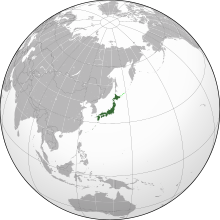 Location of Japan (dark green) | |
| Medicinal | Illegal |
|---|---|
| Recreational | Illegal |
| Hemp | Legal |

Cannabis has been cultivated in Japan since the Jōmon period of Japanese prehistory approximately six to ten thousand years ago. As one of the earliest cultivated plants in Japan, cannabis hemp was an important source of plant fiber used to produce clothing, cordage, and items for Shinto rituals, among numerous other uses. Hemp remained ubiquitous for its fabric and as a foodstuff for much of Japanese history, before cotton emerged as the country's primary fiber crop amid industrialization during the Meiji period. Following the conclusion of the Second World War and subsequent occupation of Japan, a prohibition on cannabis possession and production was enacted with the passing of the Cannabis Control Law.
As of 2024[update], the possession of cannabis for recreational and medicinal use is illegal in Japan, though a law legalizing medical cannabis was passed by the House of Councillors in late 2023. The cultivation of commercial cannabis hemp is permitted under a strictly regulated licensing system. While other East Asian and industrialized nations have generally moved to relax laws that criminalize cannabis in recent decades, Japan has maintained and strengthened laws that prohibit the use, possession, and cultivation of cannabis. The proportion of the Japanese population that has used cannabis at least once was 1.8 percent in 2019, making it the second most popular illicit drug in the country behind methamphetamine.